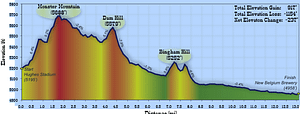I often hear from athletes “should I sign up for that race, it is really hilly”. Oh, “since my A event is not hilly, do you think I should do that hilly course to prepare?” I often hear an excuse, it was a hilly course so “I did not preform well” or by discussing the nature of the hills, they are setting themselves up for a poor performance. Many runners avoid regular hill training or racing hill courses because, well, it’s hard. Depending on the grade of the hill, lactic acid builds quickly, our heart rate shoots up, several muscles fire all at once, and we tire quickly. Unfortunately, the only way to become proficient at ascending and descending hills is to run on hills.
No doubt that running uphill and down puts and added stress on your muscles and can increase your risk for injury, if you train with the hilly course in mind you can overcome and mental and physical struggle with running hills.
I used to be intimidated by hills. More so on the bike then on the run. Running uphill is my strength, running downhill not so much. Riding uphill makes me stronger on the flats. After 24 years of competing in triathlon I have never won a race riding uphill. I am not an fast downhill rider either.
In light of the upcoming Horsetooth Half Marathon this weekend I wanted to focus on running hills. I used to shy aware from hills and internally admitted, hills “are too hard!” Now I thrive on any thing that seems “hard” including biking and running hilly courses. I prefer uphill running more then downhill running, unfortunately when you run you, you must run down! Best advice I give to newbies to to tackle each hill in training, commit to never walking up hill and you will continue to get stronger both mentally and physically. Note if you do walk uphill is it cause your muscles or lungs are fatigued?
Benefits of Running/Riding Hills-reasons you should still train on a hilly course, despite your event being a flat course.
- Hills will increase the intensity of your workout. When you increase the intensity of your workouts you expend more calories / unit of time.
- Hills will strengthen your legs (especially your quads, butt and calves). Strength precedes speed, so hills incorporated into a progressive training program will lead to more efficient and faster running
- Hills will strengthen your lungs and heart
- Hills Provide some variety to a traditional routine
Tips while running uphill
- Start with a warm-up to gradually get your legs loose and heart rate elevated (5-15 minutes)
- If you are new to hill training, progress gradually. View sample workouts below. It can be quite challenging on your body when you’re not used to it. Start with 2-4 repeats of 1-2 minutes and just run, don’t worry about pace
- When running uphill, shorten your stride and pump your arms more to help you attack the hill
- Mix up the grade and length of each hill you run on for maximum results with fitness, strength and speed.
- Always Finish any hill workout with easy jog or spin to flush the legs and cool-down.
- Stretching – focus on the calves, quads, hamstrings, glutes and lowback.
Do you live in flat terrain? you can still get all the benefits above on the treadmill
Tips when simulating uphill runs on the treadmill
- Listen to your body: Since fitness levels and running abilities vary greatly, it’s difficult to give an exact workout prescription (ie. run at a speed of 6.0 mph at 8% incline for 15 minutes). So choose a grade and pace that challenges you without causing exhaustion or muscle/joint strain.
- Try increasing the incline to 4-8% grade for 1-2 minutes at a speed that challenges you, but not a speed you can’t maintain, better to start slower and monitor your intensity via heart rate, followed by 1-2 minutes at 0% to simulate the downhill effect.
- For reference, 0% grade is exactly flat.
- A 2% grade does not seem very steep but it’s enough to make you feel a bit slow and fatigued and it like running outside.
- Most highway off-ramps are 4-percent grade.
- A 6% grade is enough to dramatically reduce your speed.
- A 10% grade would be really steep; steeper than most of the usual hills any of us who live outside of mountainous areas would run into.
Sample Workouts This are examples for Favorite Fort Collins Running Route Course Profiles
Hilly Loop or out and back.
Hilly Long Runs These runs are incredibly valuable, especially if your race is on a hillier course. These workouts need to be frequent during your build stages after you’ve built a solid injury-free base. Mixed hilly runs can be attacked in several different ways: 
Short Hills:
The focus of these short workouts is on speed, power and anaerobic energy recruitment. The grade should be relatively steep. Because you will be working extremely hard for a short period of time, your recovery time will be longer, one to two minutes, in order to bring breathing and heart rate back to normal. These short repeats are great to do during your base building phase, too, as they will help you with longer rides/runs in the future. For running, find a short hill of 100 to 200 meters in length, 4-10% grade, can be a golf course or park that you will run multiple times (these hills tend to be a bit steeper and harder and your effort shoulder increase). Same for cycling short and steep hill that will take you 30-60 seconds to power up. Your intensity, rate of perceived effort, should approach 8 to 9 out of 10. It will feel like the pace is out of your comfort zone and that you won’t be able to hold this intensity for very long. Push the pace until you reach the top of the hill. Turn around and walk easily, or coast if you are cycling, down the other side at about an RPE of 5. Repeat this 4-8x. Remember to cool-down with a 5 -15 minute at an easy pace. This workout from start to finish including warmup and cool down should not take very long. For running about 30 minutes, cycling about an hour or less.
Long and Gradual
When you are riding or running long hill climbs, the focus is more on aerobic energy recruitment and less about power and speed. These hills climbs can take up to three minutes, so it’s important to start slower and manage your pacing throughout the climb. Your perceived exertion will be approximately 6-8 on a scale of one to 10. Depending on the grade, your heart rate may exteed your aerobic zone, think about running form or pedal stroke.
Grade is gradual 6-10% so pace is slower, since length is longer, find one that takes 5-10 minutes or longer to ascend.
Hill workouts can be really taxing and consequently should only be done once or twice per week pending your fitness and experience. In addition to uphill form, it’s equally vital to practice running downhill with proper form, relaxed with a forward lean. Try not to let your legs get too far out front as it can be jarring and “put on the brakes” instead of acceleration. Make sure you’ve built up a solid mileage base before adding in too many hill workouts.
Whether you’re building strength or going for a personal best, hill training will complete a well-rounded training regime and help you to become a more complete athlete.



